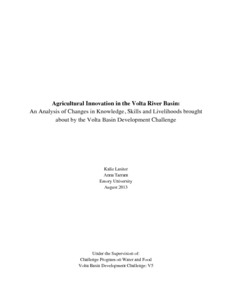Resource information
Within the agricultural development sector, innovation has been identified as a primary pathway to achieve economic, social and environmental goals. Innovation is traditionally defined as a linear and relatively homogenous process involving the invention of a “new” technology that is then transferred and adopted by an intended user. However, recent definitions of innovation in agricultural development, most notably the Agricultural Innovation Systems (AIS) definition, describe innovation as a systemic process resulting from extensive knowledge networks, interactive learning, and negotiations among a heterogeneous set of actors. One way to create an innovation system (AIS) is through the formation and utilization of certain innovation configurations known as Multistakeholder Platforms (MSPs) and/or Innovation Platforms (IPs). CGIAR’s Challenge Programs on Water and Food (CPWF) use both MSPs and IPs to bring together a diverse set of relevant stakeholders to address common challenges in river basins globally, and in the Volta River Basin system in West Africa in particular.
The Challenge Program’s Volta Basin Development Challenge Project (VBDC) focuses primarily on strengthening integrated management of rainwater and small reservoirs. The Emory graduate student research team worked in conjunction with the V5: Coordination and Change Project in order to investigate how/if the knowledge produced by V2-V4 projects in two regions in northern Ghana is contributing to innovative changes in villagers’ knowledge, skills and livelihood activities.
This particular research is part of a broader Innovation Research Project for V5 that aims to identify the concurrent changes that have also taken place among V2, V3 and V4 project implementers. Specifically, the broader research will identify project researchers’ and technicians’ definitions of innovation i.e. what they consider innovations as a result of their interactions with project participants. Because agricultural innovation involves change not only at the community level, but at the organizational and institutional levels as well, understanding the motivations and justifications of implementing partners is therefore integral to assessing if and how agricultural innovation has occurred.
Since this particular report is focused solely on the community level, it is difficult to ascertain the extent to which new practices and skills exhibited by community members are truly products of agricultural innovation systems. For the purposes of this report, therefore, innovation
ii
is defined as any adoption of “technologies” (i.e. techniques and/or products of project interventions) that have led to changes in villagers’ knowledge, skills and practices. Furthermore, this research assesses not only the changes that have occurred among project participants, but also if/how the same new skills and practices have been learned and adopted by non-participants in order to determine knowledge spread.
Using a snowball sampling strategy, the Emory graduate student research team conducted semi-structured surveys of project participants and nonparticipants in two project sites for a total of 44 surveys. Based on the analysis of these surveys, this study outlines five determinant categories of factors leading to adoption of technologies among both participants and nonparticipants: (1) involvement in a project, (2) access to inputs, (3) access to information, (4) ability to sell products that result from technologies, and (5) risk mediation.
The conclusions of this study can provide valuable insights to organizations like the CPWF VBDC on how to understand and integrate factors that determine technology adoption into future research and programming efforts. In addition, the study’s analysis of agricultural innovation systems will hopefully engage all relevant stakeholders involved in agricultural development strategies in the Volta Basin River System on how to conceptualize, create and implement innovation configurations that not only produce, exchange and use knowledge, but do so for the purpose of enabling systemic and structural change. Without such change, achieving poverty reduction and sustainable natural resources management will remain a challenge.


